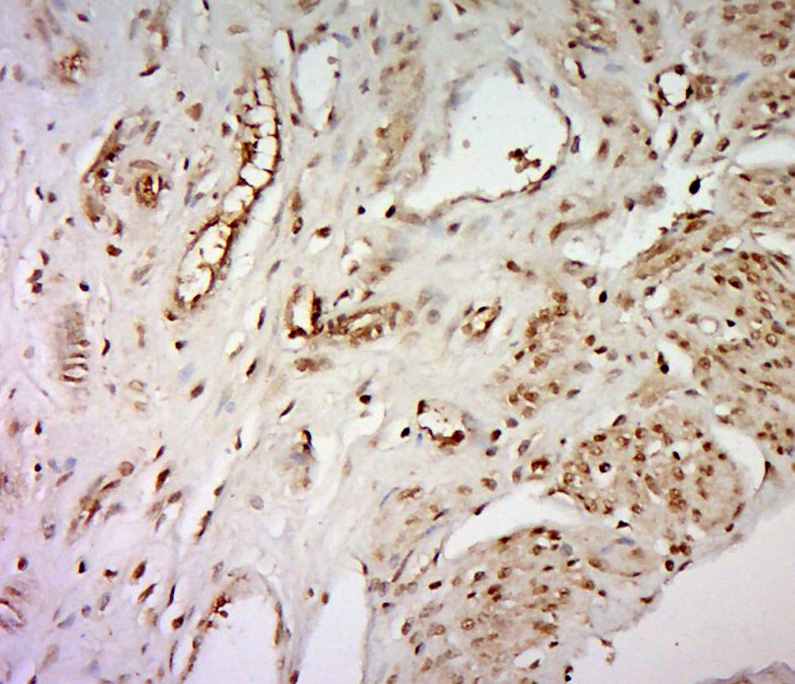
Rabbit Anti-WDR61 antibody
Meiotic recombination REC14 protein homolog; REC14; Recombination protein REC14; SKI8; WD repeat containing protein 61; WD repeat domain 61; WDR 61; WDR61_HUMAN.
View History [Clear]
Details
Product Name WDR61 Chinese Name WD重复膜蛋白61抗体 Alias Meiotic recombination REC14 protein homolog; REC14; Recombination protein REC14; SKI8; WD repeat containing protein 61; WD repeat domain 61; WDR 61; WDR61_HUMAN. Research Area Cell biology Cyclin Immunogen Species Rabbit Clonality Polyclonal React Species Rat, (predicted: Human, Mouse, Dog, Cow, Horse, Sheep, ) Applications ELISA=1:5000-10000 IHC-P=1:100-500 IHC-F=1:100-500 IF=1:100-500 (Paraffin sections need antigen repair)
not yet tested in other applications.
optimal dilutions/concentrations should be determined by the end user.Theoretical molecular weight 33kDa Cellular localization The nucleus cytoplasmic Form Liquid Concentration 1mg/ml immunogen KLH conjugated synthetic peptide derived from Human WDR61: 121-220/305 Lsotype IgG Purification affinity purified by Protein A Buffer Solution 0.01M TBS(pH7.4) with 1% BSA, 0.03% Proclin300 and 50% Glycerol. Storage Shipped at 4℃. Store at -20 °C for one year. Avoid repeated freeze/thaw cycles. Attention This product as supplied is intended for research use only, not for use in human, therapeutic or diagnostic applications. PubMed PubMed Product Detail WDR61 is a subunit of the human PAF and SKI complexes, which function in transcriptional regulation and are involved in events downstream of RNA synthesis, such as RNA surveillance (Zhu et al., 2005 [PubMed 16024656]).[supplied by OMIM, Mar 2008].
Function:
Component of the PAF1 complex (PAF1C) which has multiple functions during transcription by RNA polymerase II and is implicated in regulation of development and maintenance of embryonic stem cell pluripotency. PAF1C associates with RNA polymerase II through interaction with POLR2A CTD non-phosphorylated and 'Ser-2'- and 'Ser-5'-phosphorylated forms and is involved in transcriptional elongation, acting both indepentently and synergistically with TCEA1 and in cooperation with the DSIF complex and HTATSF1. PAF1C is required for transcription of Hox and Wnt target genes. PAF1C is involved in hematopoiesis and stimulates transcriptional activity of MLL1; it promotes leukemogenesis though association with MLL-rearranged oncoproteins, such as MLL-MLLT3/AF9 and MLL-MLLT1/ENL. PAF1C is involved in histone modifications such as ubiquitination of histone H2B and methylation on histone H3 'Lys-4' (H3K4me3). PAF1C recruits the RNF20/40 E3 ubiquitin-protein ligase complex and the E2 enzyme UBE2A or UBE2B to chromatin which mediate monoubiquitination of 'Lys-120' of histone H2B (H2BK120ub1); UB2A/B-mediated H2B ubiquitination is proposed to be coupled to transcription. PAF1C is involved in mRNA 3' end formation probably through association with cleavage and poly(A) factors. In case of infection by influenza A strain H3N2, PAF1C associates with viral NS1 protein, thereby regulating gene transcription. Required for mono- and trimethylation on histone H3 'Lys-4' (H3K4me3), dimethylation on histone H3 'Lys-79' (H3K4me3). Required for Hox gene transcription. Component of the SKI complex which is thought to be involved in exosome-mediated RNA decay and associates with transcriptionally active genes in a manner dependent on PAF1C.
Subunit:
Component of the PAF1 complex, which consists of CDC73, PAF1, LEO1, CTR9, RTF1 and WDR61. Component of the SKI complex which consists of WDR61, SKIV2L and TTC37.
Subcellular Location:
Nucleus. Cytoplasm (Probable).
Similarity:
Contains 7 WD repeats.
SWISS:
Q9GZS3
Gene ID:
80349
Database links:
UniProtKB/Swiss-Prot: Q9GZS3.1
Product Picture
References (0)
No References
Bought notes(bought amounts latest0)
No one bought this product
User Comment(Total0User Comment Num)
- No comment



 +86 571 56623320
+86 571 56623320
 +86 18668110335
+86 18668110335

